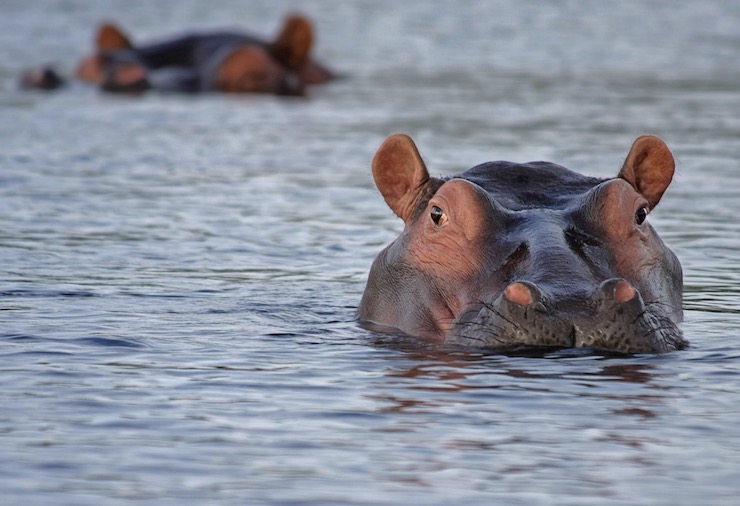
Native to the rivers and lakes of sub-Saharan Africa, hippopotamuses are the second heaviest land animals. Weighing upwards of 8,000 lbs these herbivores spend the majority of the day submerged in murky water to escape the scorching heat of the sun. When the sun sets, they emerge from the waters traveling between 3-6 miles to search for vegetation. They are considered nocturnal, but they do not spend the whole day sleeping, rather they rest and socialize. Though hippos are not classified as endangered animals, they are vulnerable to endangerment. Hippo populations have decreased dramatically due to poaching and habitat loss. Conservationists have been trying to research hippos to protect them with very little success, until now.
Hippos are known for being extremely protective of their territory. While claves (baby hippos) are vulnerable to crocodiles, lions, or hyenas, adult hippos have no natural predators. They are highly aggressive and are considered one of the most dangerous animals on the planet, responsible for an estimated 500 deaths to humans a year. Being able to study them in their natural habitat is far too risky. Researchers have to rely on trail cameras or aerial images to study these vulnerable creatures. However, trail cameras only track hippos for a short portion of time, and capturing footage by airplane is very expensive. Also, images taken from planes are often unreliable since the planes have to stay at a high altitude and the waters are dark and muddy. That is why a collaboration between Elephants Without Borders and a postgraduate research student from New South Wales University in Sydney, Australia decided to use drones to study hippopotamuses.
Victoria Inman studies ecology, animal behavior, and wetland processing through remote sensing technology. She was based in Batswana’s Chobe National Park for 18 months until late 2019, collecting data on hippos by flying drones over their watery resting grounds and feeding trails. She was able to fly a drone over a research site several times a day to collect images that were then compared to each other, along with images taken by stationary trail cameras. She was also granted permission to use her drone at nighttime while the hippos are most active, something that had never been done before. Unlike many creatures in the wild, hippos are not bothered by the sound of a drone so Victoria was able to get closer to these aggressive herbivores than ever before.
By slowly flying the drone at an altitude of about 130ft above the water, Victoria was able to gather great detail on her subjects. To have captured these same images with a plane at an altitude of thousands of feet would not have been possible. “The bird’s-eye perspective the drone gave us made it a lot easier to differentiate between individual hippos, even when they were crowded together,” Victoria said. With the crystal clear images from the drone’s camera, Victoria was able to count hippo populations, monitor their trails, get measurements on individuals, see how they impact the environment, and in turn how they are impacted by the environment.
One remarkable sight captured by Victoria’s drone may lead to a new understanding of hippos and epimelectic behaviors, or how animals express emotions. Early one September morning in 2018, Victoria noticed that the lagoon she had been monitoring with her drone was unusually empty. Where she would normally find close to 25 hippos cooling off was only one adult female and a floating object. This object turned out to be the carcass of a calf, presumably the female’s baby. For over 11 hours the female struggled to keep the carcass afloat and out of the jaws of preying crocodiles. As the day wore on, other members of the pod joined the distressed mother to keep the crocodiles at bay. At times the pod would blow bubbled in the water around the baby and mother, a known form of communication between hippos. It seemed as if the mother hippo was grieving the loss of her baby while the pod showed support.
Victoria had personally never seen this type of behavior displayed in the wild. More and more studies show that other social creatures like apes and whales also present epimelectic behaviors. The footage captured by Victoria’s drone is a first considering how difficult it is to film hippos in the wild. The data collected will surely support continued research missions to better understand animal behavior and the surrounding environment. But perhaps one of the biggest motivators for conducting research with drones is simply due to their affordability.
Victoria said that the drone she used for this project was an off the shelf DJI Phantom 4, an easy to use, high quality, lightweight drone that can be found for as little as $800. Compared to the costs of other research equipment, drones are one of the least expensive tools available. “Drone data could be routinely collected in different river systems, providing a guide to the numbers in hippo pods, seasonal changes and the ability to track the long-term status of hippo populations,” Victoria said. “Our study shows that small, commercially available drones are a simple, affordable and effective method for wildlife conservation organizations to monitor threatened species.”
|